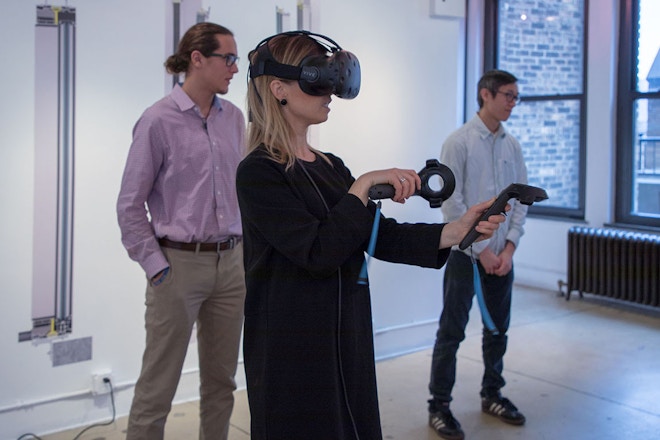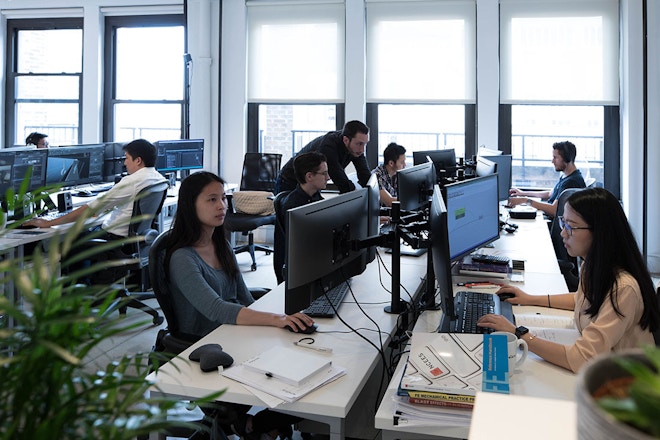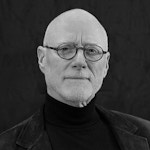
Digital Designers in NYC Providing a Unique Facade Procurement Experience

A small team of young digital designers and technicians at the Virtual Construction Lab (VCL) of Schüco in New York City is breaking new ground in the application of virtual reality (VR) techniques to building facade technology. A new way for clients to experience and evaluate facade products is emerging.
Imagine donning a VR headset and slipping into a virtual 3D building interior; you recognize it as your new office design. You do a complete turn exploring this new domain. Two walls of the enclosure are an interesting glass system overlooking a cityscape. You walk along the facade taking in the joint details. You back away, and at the click of a hand control one wall changes to an alternate facade system type. Another click and the other wall changes to yet another system type. You cycle through the systems comparing the looks. You drag and drop windows and doors. The click of another hand-control projects technical data relative to the active facade system into your field of view.
Another finger click selects a window component and you draw it toward you, where it hangs suspended within reach. You draw a hand trigger and the window components disengage and separate, revealing exactly how the window is put together. Release the trigger and the components slip back together. Awesome!
You send the window back to its place and notice a door leads to an exterior deck. You move to the door—a slider—grasp the handle, rotate it downward and slide the door open. A cacophony of urban sound assaults you, and you are suddenly aware of how much sound mitigation the facade system has been providing you. You close the door again and substitute it with an acoustical glass door alternate product, and you can hear the difference in outdoor-indoor sound transmission. You reopen the door and move onto the deck taking in the excellent view of the city, then looking back to see your proposed facade system from the outside. Not bad, you think, as you cycle through the alternatives and select your preference.

VR technology is poised to provide an absolutely unique facade evaluation and procurement experience for the building team. This is the potential. And VCL is already delivering the experience. A November 2017 release included the following modules:
- Facade swap module – allows user to see multiple variations of a unitized or stick facade.
- Acoustics module – features the ASS 77 PD with live sound attenuation as the user opens and closes the door. This module was developed with real acoustic data and is unprecedented in the VR industry.
- Component blow out module – users can view assembled or expanded featured Schüco systems with the ability to pick up and examine individual components.
But the VCL team promises that this is only the beginning. Look for progress updates on this exciting development work in future editions of SKINS.
The VCL will be demonstrating the technology at the upcoming Facade Tectonics World Congress in Los Angeles on March 12-13.

Mic Patterson, PhD, LEED AP BD+C
Ambassador of Innovation and Collaboration
Facade Tectonics Institute
Send Email
Mic Patterson is a designer, researcher, educator, futurist, author, photographer and entrepreneur. He has concentrated his professional and academic career on advanced facade technology and sustainable building practices. He pioneered the introduction of structural glass facade technology in the United States in the 1990s, implementing diverse and novel applications including cable trusses, cable nets and grid shells. Patterson was among the founding group of the Advanced Technology Studio of Enclos, where he works as the Vice President of Strategic Development. He is a co-founder of the Facade Tectonics Institute and serves on the steering committee, and co-founder of the Facades+ conference series. He is on the technical research committee for GlassCon Global and a member of the Advisor Group for the Council for Tall Buildings and Urban Habitat. He has twice been named among the industry’s most influential by US Glass magazine. Patterson is a Ph.D. candidate in the School of Architecture at the University of Southern California with a research focus on sustainable facade renovation practices. He has taught, written extensively, and lectured internationally on diverse aspects of advanced facade technology. He is the author of Structural Glass Facades and Enclosures, published by Wiley.
All photos by Katie Gould © 2018 Virtual Construction Lab of Schüco.
Looking for something specific?
Search our extensive library.
FTI’s SKINS email is the central source for the latest in building skin trends and research.
All emails include an unsubscribe link. You may opt out at any time. See our privacy policy.








